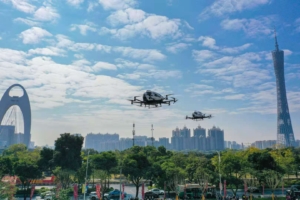Enabling safe and seamless drone operations
March 2022 – From test flights with a scaled model of an Airbus A320, large demonstration flights for UAM to integration of manned and unmanned air traffic: there are numerous projects that Royal NLR is working on to enable and accelerate drone operations. NLR is the knowledge partner in this field for industry and government, taking into account rapidly changing societal, economic and security challenges. These are some of the key developments of this year.
AMU-LED: major flight demonstrations this summer
AMU-LED (Urban Air Mobility – Large Experimentation Demonstrations) is looking into the capabilities of U-space to enable Urban Air Mobility (UAM) by answering questions related to the maturity of concepts and technology, the challenges, and what needs to be done to implement this new form of mobility in cities.
To his end, AMU-LED will perform real-life UAM demonstrations and flights using U-space and deploying several types of drones to showcase different scenarios, use cases and applications (e.g. air taxis, emergency services, delivery of goods, surveys, etc.) to demonstrate and investigate the UAS ground and airborne platforms and finally, to assess safety, security, sustainability and public acceptance. This summer, several major flight demonstrations will take place in the UK, Spain and The Netherlands.
NLR is work package leader for the demonstration flights. Marta Tojal Castro, projectleader, will give a presentation on AMU-LED and an update on the flight demonstrations this summer, at the Amsterdam Drone Week on 30 March at 11.00 hours.
This research has received funding from the SESAR Joint Undertaking under the European Union’s Horizon 2020 research and innovation programme.
Hydrogen drone
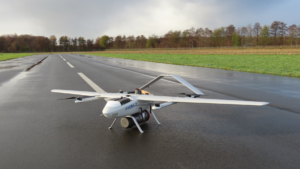 Hydrogen as a fuel is considered to be an important alternative for future sustainable aviation.
Hydrogen as a fuel is considered to be an important alternative for future sustainable aviation.
Hydrogen is a lightweight fuel with a 3-4 times higher energy density than kerosene. It can be stored in tanks both in gaseous and liquid form. It can be burned in conventional combustion engines, as well as transferred highly efficiently into electric power with fuel cells, as an alternative to batteries. In cooperation with Dutch industry and universities, NLR obtained first-hand experience in designing, selecting, testing and improving hydrogen components (gaseous and liquid) suitable for drones, as well as extensive safety analysis and test procedures. The NLR HYDRA projects support the standardisation and certification of hydrogen drones for commercial applications, while also preparing for upscaling for large manned aircraft. The first flight of the liquid hydrogen drone is expected to take place in mid 2022.
Watch ‘Flying on hydrogen‘.
DELMO: optimising performance, energy consumption and noise impact
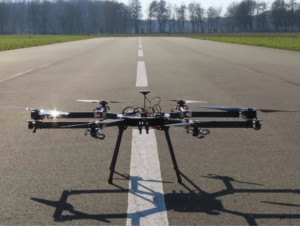 NLR Living Lab has developed the DELMO drone (DEdicated Lifting MOtors). An innovative concept for a multirotor drone with two different sets of propellers to optimise the performance, energy consumption and noise impact.
NLR Living Lab has developed the DELMO drone (DEdicated Lifting MOtors). An innovative concept for a multirotor drone with two different sets of propellers to optimise the performance, energy consumption and noise impact.
The DELMO prototype has two large rotors which carry about 70% of the total weight. The other four smaller rotors are used to produce the remaining thrust and to control (stabilise and move) the drone. In this concept, the large lifting rotors are constantly active and rotate with a constant revolutions per minute (RPM), which requires a steady current and thus avoids peaks. The four smaller rotors rotate with a variable RPM for the stability and control, while generating less peak currents due to the small size of the rotors. As the majority of the lift is carried by the large lifting rotors at constant RPM, the performance of the drone can be better optimised than “classic” drones. A constant RPM is also more suited to reduce noise annoyance since the noise pollution from the lifting rotors is not varying. A specific noise frequency can be targeted and noise mitigations specific to a constant frequency incorporated.
The DELMO prototype is presented at the NLR stand at the Amsterdam Drone Week in the RAI, Amsterdam, on 29-31 March.
DigiCity
NLR is developing DigiCity, an innovation and test centre for drones. DigiCity is the missing link between product development and market approval (including certification).
DigiCity will be a flexible and realistic operational urban environment where innovative companies can experiment and test their drones. A monitoring network creates an accurate picture of the impact that the drones have on the city environment and vice versa. Assessing how ‘city-proof’ the drones in the facility are and using the monitoring system makes clear exactly what is still needed for their practical application, which simplifies authorisation procedures and shortens the time to market. DigiCity will be constructed from several dozen reconfigurable containers with appropriate instrumentation – wind sensors and other measuring devices. This will allow various built-up area configurations to be simulated. Various groups will be able to test here. Avy, one of the launching customers of DigiCity, will be working there with NLR on developing a VTOL hydrogen-powered transport drone. DigiCity will be built to the NLR Drone Centre and on the new Mobility and Infrastructure Test Centre (MITC) in Flevoland (NL).
This facility is being realised through a subsidy from Kansen voor West (Opportunities for the West) within the REACT EU framework.
Metropolis II
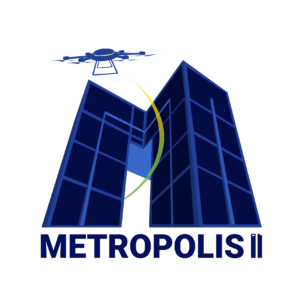
Thousands of drones were unleashed in a simulated Vienna as part of the SESAR research program Metropolis II for the development of U-space.
In the Metropolis I project, the optimal structure of the airspace is to guarantee safety with a high density of urban air operations was researched. Metropolis II focuses on developing a unified separation management function for unmanned traffic that takes both the required airspace design and the necessary (tactical and strategic) separation algorithms into account at the same time. It is hypothesized that such a unified approach will be necessary to facilitate large volumes of unmanned traffic in tightly confined urban airspace. Within the project, three different concepts are developed to safely manage the drones: centralised, decentralised and hybrid control of drones. The centralised concept mainly focuses on strategic deconfliction, each drone gets a flight plan pre-flight that in space and time are separated from each other. In the decentralised concept the responsibility of determining the flight plans lies with each individual drone, that do not have any information about each other’s flight plans and have to perform maneuvers to guarantee separation between each other in case of a conflict during the flight. The hybrid concept is a combination of the two concepts named above: both strategic and tactical deconfliction is applied. Learn more about Metropolis II.
This research has received funding from the SESAR Joint Undertaking under the European Union’s Horizon 2020 research and innovation programme.
Scaled aircraft testing to accelerate radical new aircraft design
How can you test a ground-breaking new aircraft design without first having to build a very expensive prototype? And how can you make measurements on new aircraft propulsion systems based on battery technology or hydrogen?
SCALAiR is part of Clean Sky2 Large Passenger Aircraft, and aims to validate scaled flight testing as a viable means for de-risking disruptive aircraft technologies and aircraft configurations to a high technology readiness level. The goal is to develop a highly representative scaled aircraft of an actual aircraft, equipped with very accurate flight test instrumentation to perform measurements during the tests. This will introduce a very cost-effective approach to developing radical new aircraft, as needed for more sustainable aviation. The NLR activities involve ‘Test Aircraft Preparation and Qualification’. NLR together with Airbus, ONERA, CIRA, TU and Orange Aircraft, are working on a test method for flying scale models. The idea is that a scale model can bridge the gap between the research and practical worlds: computer models can be made more accurate by practical testing using geometrically scaled-down models. The ultimate aim is to be able to measure differences in behaviour between the scale model and the real aircraft, allowing rules for scaling to be determined. For the first tests for the SCALAIR project in 2021, a 1:8.5 scale model of an Airbus A320 aircraft (the Scaled Flight Demonstrator or SFD) was used to taxi at high speed on the runway at Deelen airfield. The 1st flight is planned for this year, first in Deelen and later in Italy.
This project has received funding from the Clean Sky 2 Joint Undertaking under the European Union’s Horizon 2020 research and innovation programme.
Detect and avoid systems
To enable safe airspace integration of unmanned aircraft, a Detect And Avoid (DAA) system is required to evade other (manned) aircraft.
One solution is to use a Cooperative Traffic Sensor based on transponder signals. Such a sensor is not yet available with a small form factor suitable for unmanned aircraft. Within the Airborne Data Collection on Resilient System Architectures (ADACORSA) project, such a sensor will be developed and tested in cooperation with partners, both from industry and research organisations. NLR is developing a Direction Finder for the Cooperative Traffic Sensor (CTS) and integrates this with a Mode-S interrogator, developed by project partner Celestia Technology Group. The DAA system uses algorithms developed by NLR for semi-automatic avoidance of other aircraft. Solutions include miniaturisation of the DAA system suitable to be integrated onboard of small and mid-sized unmanned
aircraft; sensor suite advancement to include a direction finder to measure the azimuth such that the relative position to the intruders is known; information from ADS-B (manned intruder aircraft) will be used to further increase detection of current airspace users.
Download: Enabling safe and seamless drone operations
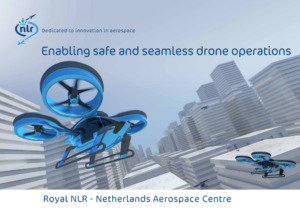 We have selected some of the projects, research and capabilities that we have developed ourselves and together with partners in this booklet for you to read and discover how NLR can support your drone operations.
We have selected some of the projects, research and capabilities that we have developed ourselves and together with partners in this booklet for you to read and discover how NLR can support your drone operations.
Download the booklet.
